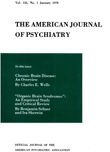Disulfiram (Antabuse) Psychosis
Abstract
A case of disulfiram psychosis is presented; the patient also had grand mal convulsions even though he had no prior history of epilepsy.
The literature on disulfiram psychoses is reviewed, and it is pointed out that there is little conformity among different authors in their use of this term. For the sake of clarity, the 52 cases previously reported as psychoses secondary to disulfiram ingestion are classified into three groups. In both Group I and Group II, delirium is present. However, in the latter group the psychosis is complicated by other symptoms, such as depression, paranoid ideations, or manic behavior. Group III consists of those psychoses without delirium.
The evidence that disulfiram does have a deleterious effect on the central nervous system of some individuals is discussed. Also presented is the evidence that psychogenic factors contribute to the genesis of these psychoses, particularly in the cases of Group II and Group III.
Access content
To read the fulltext, please use one of the options below to sign in or purchase access.- Personal login
- Institutional Login
- Sign in via OpenAthens
- Register for access
-
Please login/register if you wish to pair your device and check access availability.
Not a subscriber?
PsychiatryOnline subscription options offer access to the DSM-5 library, books, journals, CME, and patient resources. This all-in-one virtual library provides psychiatrists and mental health professionals with key resources for diagnosis, treatment, research, and professional development.
Need more help? PsychiatryOnline Customer Service may be reached by emailing [email protected] or by calling 800-368-5777 (in the U.S.) or 703-907-7322 (outside the U.S.).



